

# of episodes
episode average
26
3.26
SEASON BEST
Tapestry
Lessons
Chain of Command (I-II)
Frame of Mind
Schisms
series Top 10
series Flop 10
2 episodes
0 episodes
SEASON WORST
The Chase
Rascals
Man of the People
Aquiel
Rightful Heir
5.26/6.1 TIME’S ARROW (I-II)
Data's 500-year-old head is found in San Francisco.

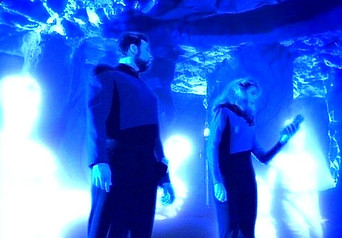
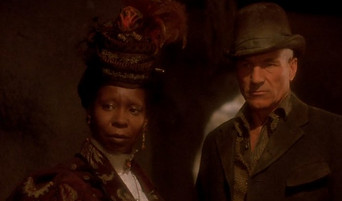
WATCH FOR CONTINUITY
Star Trek has rarely failed a time travel episode, and while this one is no exception, it is an overall weaker story than other comparable two-parters (or even standalones). This is partly due to the large amount of filler material that, while useful to color the era and give Clemens a big role, results in a slow and unfocused episode --- if a highly entertaining one. The premise is exceptional: Data’s head is found in a cave under San Francisco and dated to be about a half-millennium old. The finding jump-starts an exciting quest to stop a devious alien race from preying on 1800s humans. And if this wasn’t exciting enough, the writers pick this as Guinan and Picard’s backstory. This was a daring gamble, and for the most part it pays off. The episode is annoyingly vague about why Guinan is on Earth in 1893. Surely she has traveled there from space, given her familiarity with Data’s talk of spaceships; and yet she’s entirely unfamiliar with anything else when it comes to Picard, such as his technology or the very concept of time travel; and as we are given no explanation, we must fill in a lot of gaps. While this may be exciting for prospective non-canon authors, it is unnerving for the audience as a whole, as Guinan’s origin story is left criminally under-explained. Twain/Clemens is another gamble, and it too is a mixed bag. On the one hand, Jerry Hardin brings the character to life better than anyone else could have, and the scenes on the Enterprise are genuinely entertaining. On the other hand, Twain is so accessory to the main plot that his role could have been excised with no consequences, so it becomes difficult to justify such emphasis. In the end, the script amounts to more than the sum of its parts and “just works,” as it were. But other than a handful of funny gags, the botched attempt at Picard-Guinan, and one political conversation about the future of humankind, the episode has little to say, and it shows.
Barclay faces his transporter phobia, but his fear is well founded.
6.2 REALM OF FEAR
After the half-failure of S4’s “The Nth Degree,” Barclay finally returns with a script perfectly suited to his character development. After all, a person as phobic as Reg would certainly not be healed after making a couple of friends and coming out of his shell for the first time. Indeed, all through VOY we will see a fundamentally unchanged Barclay who however takes some steps in the right direction... which is a perfectly accurate portrayal of many common anxiety disorders. This episode in particular is fascinating, as Reg deals with a very realistic fear (though adapted for TNG’s technological level) and has sensible reactions. The resulting mystery is engrossing and its resolution genuinely startling, in all the good ways. Schultz’s sensitivity to Reg’s persona also allows him to portray him with subtlety and efficacy. If there’s one problem with this episode is its portrayal of the transporter. While surely we cannot know exactly how a non-existing technology would work, this episode contradicts what little we do know and what we have seen in previous episodes. Remaining conscious during transport, to the point of being able to move and interact with matter “inside” the beam, flies in the face of science and common sense. This contrivance demands a pretty significant suspension of disbelief, which not all viewers will be willing to make.
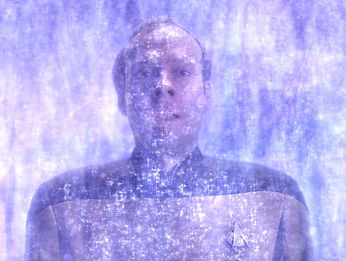
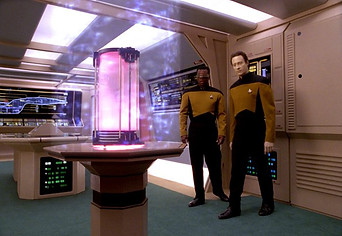
WORTH WATCHING
6.3 MAN OF THE PEOPLE
A diplomat uses women as receptacles for his negative emotions.

SKIPPABLE
This is a bad mixture of S3’s “The Price” and S5’s “Violations”: a hot-shot negotiator who hides a big secret and a creepy alien telepath who assaults Troi. We’ve seen it before, and the script gives us no reason to see it again. The “mystery,” to be charitable, is painfully obvious from the start, and its discovery by the crew is not at all exciting, dramatic, or involving. Instead, we’re regaled with increasingly ridiculous scenes of Troi acting selfishly or provocatively, which is boring and annoying. The only good scene is the Troi-Riker ending, but too little too late. This could have been a metaphor for how women are often forced to fulfill men’s emotional needs to their own detriment... but alas it’s not.
Cpt. Montgomery Scott has remained alive inside a transporter beam for 75 years.
6.4 RELICS
Scotty becomes the third TOS regular after McCoy and Spock to guest star in TNG (incidentally, the only other series regular from another show to guest star in TNG is Siddig El Fadil, who reprises his DS9 role of Dr. Bashir in S6’s “Birthright”). Scotty’s episode is definitely weaker than Spock’s, although to be fair it’s also less invested. The writers are sensitive both to Scotty’s persona and to his reception by audiences, so they concoct a scenario that is rich in opportunities for humor, melancholy, and technobabble. The only downside of potraying Scotty like an old grouch is that both he and La Forge come across as disagreeable. While this may make sense, by the time they have set aside their differences the audience may no longer care enough to rejoice at their newfound friendship. Ironically, Scotty’s rapport with Picard is much more rewarding, and not only because it is set on the bridge of TOS’s Enterprise. It’s also a pity that the Dyson Sphere concept --- one of the most exciting ideas ever conceived in science-fiction --- would be wasted in this way: the Dyson Sphere could be replaced with any nondescript space anomaly with virtually no changes to the script, which is upsetting. On the other hand, the idea of transporter suspension is brilliant, and I wish that it had been used more frequently.


WORTH WATCHING
6.5 SCHISMS
Extra-dimensional aliens abduct the crew to perform experiments.
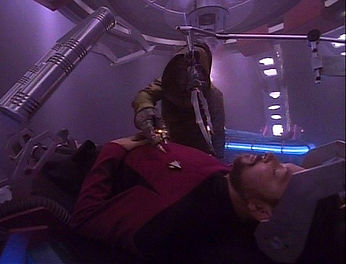
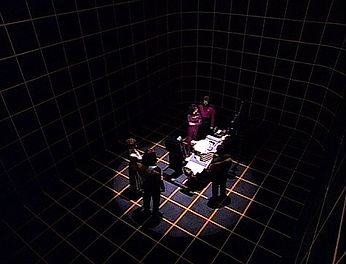
SEASON BEST
A show where non-human characters are the norm still manages to pull off a convincing “alien abduction” story, thanks to an understated story where the tension builds up slowly and peaks spectacularly. The premise is extremely simple (some crew members are weirded out by everyday objects) and gives away nothing of the eventual plot. Indeed, the abduction scenario isn’t even hinted at until the halfway point. As I have said before, there’s a fine line between filler and buildup, and this script falls solidly on the latter side. The holodeck reconstruction scene is delightfully bone-chilling, reminiscent of similar abduction narratives that we’ve gleaned from a variety of media in the XX century. Likewise the specific incidents that perturb the crew are believable, from Riker’s sleeplessness to Data’s loss of time. My favorite part of the episode is La Forge’s explanation of why the aliens have targeted the Enterprise: his sensor modifications “dug too deep” into the subspace domain and found something that wasn’t supposed to be there. The idea that there are species who live far beyond our perceptual realm in places that are inaccessible by human technology is scarier than any alien abduction scenario, and the episode does a good job at portraying this Otherness --- except, perhaps, for the aliens themselves, who despite the cloaks look and behave pretty similarly to any species of this universe. But despite this problem, the episode remains one of the most unsettling installments of the whole show.
A human girl's newfound powers draw the attention of the Q Continuum.
6.6 TRUE Q
An intriguing premise -- a human with Q powers -- receives pretty good treatment in this episode, despite a few hurdles along the way. It’s only to be expected that some Q may have wanted to leave the Continuum, and that some of these may have reproduced in a mortal fashion; VOY would explore this possibility even further. So the plot is not at all far-fetched, despite its apparent absurdity. Indeed, Amanda (played well by Olivia D'Abo) is a believable character, and while her juvenile love fantasy about Riker is trite, we care about what happens to her enough to keep watching. This is especially important as Q’s usual gags and machinations get old soon. In addition to a strong central character, the episode’s main goal is clearly to pose the audience the “what-if” question: what would you do if you became omnipotent? Several crew members are asked this question directly, and we’re shown Amanda’s journey from denial to immaturity and finally to conscientiousness; and while this is just the standard coming-of-age story arc (but with Q powers thrown in the mix), it is effective precisely because it is tried and true. The inevitable conclusion is well done and does not leave a bitter taste like many other Q episodes, so much in fact that this is one of the better ones --- and unsurprisingly, it is among those where John DeLancie’s antics are kept to a mininum.

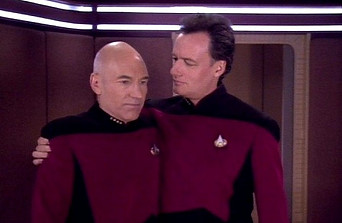
WORTH WATCHING
6.7 RASCALS
A transporter accident turns Picard, Ro, Keiko, and Guinan into children.

SKIPPABLE
With all the talented child actors available at the time of filming (early 1990s), it is infuriating that production landed on these four. The kids’ lack of skill makes this unwatchable, and a script that fails to respect its premise also doesn’t help, as the characters mostly speak and act as actual children despite the reassurance that their minds are adult. The Keiko-O’Brien scene is the exception, but it’s too cringe-worthy to be truly valuable The result is TNG’s single most awkward episode, surpassing even S1’s disasters. The only redeeming quality is that the Ferengi takeover is actually entertaining, but by then the audience just wants the episode to be over already, so that alone can’t do much.
Worf and Alexander are trapped in a malfunctioning holodeck.
6.8 A FISTFUL OF DATAS
Few trapped-on-the-holodeck stories are as innovative as this one. An apparently banal pretext yields an entertaining scenario as Alexander convinces Worf to try out a Far West holo-novel. The ensuing gags are hit and miss. On the one hand, there is far too much caricaturing and environment-building filler, ripe with a questionable Southern drawl and similar stereotypes. On the other hand, the idea of replacing most characters with Data is hilarious, and Spiner once more shows off his versatility as a character actor (though never as much as he does in S7’s iconic “Masks”). Though the eventual resolution is basic, it’s not for that reason any less entertaining, so the episode as a whole works.
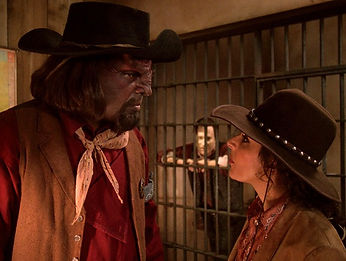
WORTH WATCHING
6.9 THE QUALITY OF LIFE
Data advocates for another artificial life-form's right to life.
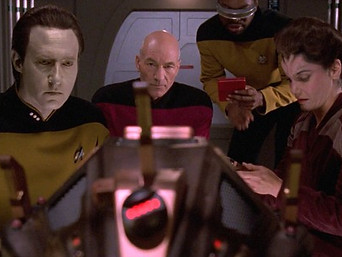

WORTH WATCHING
This is TNG’s last foray into a series of episodes that share a thematic similarity: first contact with a potentially sentient new life-form whose form and essence are very alien. Such stories are cornerstones of all science fiction, and Star Trek usually does them well. This one is no exception. A very simple premise yields a nuanced and careful story, and although it does not live up to the lofty ideological debate of S2’s “The Measure of a Man,” it presents a variety of intriguing arguments. Instead of a courtroom drama, this script opts for more empirical trial by fire, which is more sensible given its setting on a remote mining facility. Thus, the focus is less on the definitions of life and sentience and more on practical advocacy and whether life-forms can behave in their own best interests. Data’s positionality vis-a-vis this issue is well conceived: once more the writers (and Spiner) are capable of creating a deep and heartfelt role for a supposedly emotionless character. The script also intelligently draws parallels to Data’s own trial to establish his sentience: as Picard would advocate for him, so does he advocate for the Exocomps, who, in his own words, “have no one” to speak for them. The resulting episode is certainly slow-paced, but with a clarity of purpose that allow it to be entertaining despite the basic premise.
Picard is imprisoned by Cardassians.
A new captain negotiates his release.
6.10/6.11 CHAIN OF COMMAND (I-II)
There is something of the biblical Job in Picard: the staunch defender of Federation ideals who is repeatedly hurt for his beliefs. And while surely the Borg abduction is the defining element of his personality, this torture at the hand of a Cardassian interrogator is right up there. But unlike the political implications of Locutus, this one is personal. Despite all the posturing about “revealing tactical information” about Minos Korva, the only real goal of Picard’s torture is the only real goal of all torture: to dehumanize and dominate. And this is precisely what Picard doesn’t allow Gul Madred to do. Through the six-year-old boy anecdote and the four-lights riddle, Picard skillfully turns the tables on his torturer, rising from a position of absolute submission to one of absolute moral authority in the span of a few words. His resistance (which is far from futile, as he has well learned...) is all the more heroic because it is personal, not political. Aside from a few well-placed jabs at a wasteful and militarized Cardassian culture, Picard’s engagement with Madred is almost entirely psychological, reflecting the view that torture is always an exchange between two people, not two systems. Needless to say, Stewart delivers his best performance in TNG yet, showing once more what a classically trained theater actor can do with a good script. It helps, too, that his foil is none other than David Warner, who also excelled as Chancellor Gorkon in Star Trek VI.
While less gripping, the episode’s secondary plot arc is pivotal to the overall plot and well executed. Ronny Cox delivers an extraordinary Captain Jellico. Though he may have been designed to elicit hatred by the audience, he quickly became a fan favorite despite (or because of) his ruthless disposition. Jellico’s rivalry with Riker is sensible, as is his mentality, but the script plays its hand a little heavily on both accounts, perhaps hoping to reinforce the Picard-Riker bond through a counter-factual reversal of fortunes. This turns out to be tedious at times. But Jellico’s endgame is top-notch, and his daring tactics eventually secure Picard’s release.
The only sore spot in an otherwise excellent episode is the premise on which it is founded. It stretches even the most permissive imagination that three senior officers on the Federation flagship would be sent on a top-secret black op merely because of a tiny detail in Picard’s past. It’s even more unbelievable that the operation would be a Cardassian trap designed specifically to appeal to that tiny detail. We must conclude that there are quite a few illogical types in both Starfleet and in the Empire --- while of course the only illogical types were the writers who landed on this pretext when many others were available. Of course, this is forgivable in light of the quality of the rest of the episode.
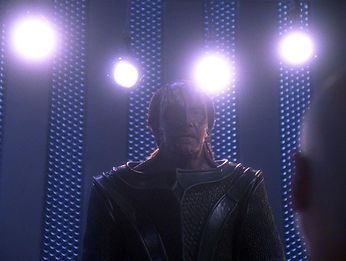

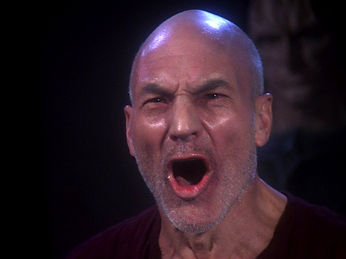
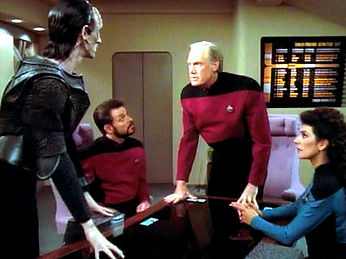
SEASON BEST
6.12 SHIP IN A BOTTLE
Sentient hologram Prof. Moriarty is reactivated accidentally.
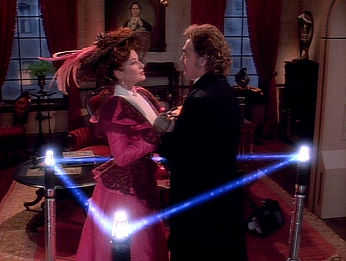
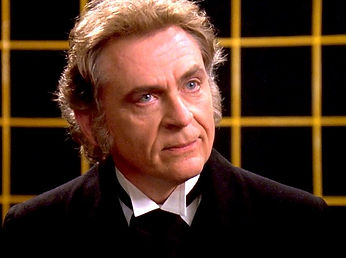
WORTH WATCHING
The premise for the return of one of the most beloved antagonists from the show’s early seasons is rather feeble: his program is accidentally uncovered by Lt. Barclay during routine maintenance. But of course, this is necessary, for surely the crew would not intentionally let loose an adversary that has greatly endangered them before. And surely enough, Moriarty is back at his old game, once more locking three crew members on the holodeck and taking control of the Enterprise. But whereas the main focus of S2’s “Elementary, Dear Data” was the possibility of a holo-character gaining sentience, this script focuses on the natural consequence of that philosophical supposition: the thin line of demarcation where the real world and the simulated world coalesce. Moriarty’s sleight of hand is quite basic, in retrospect, but believable and well executed at first. The episode is extremely apt at fooling us into believing that it will analyze one philosophical conundrum (how a sentient simulation was able to leave the simulated world) while in fact it is analyzing another (how we can tell the difference between reality and simulation). The eventual resolution and conclusion strike at the core of the latter issue. The crew’s two-can-play-that-game tactic wins the day in the end, but it reveals the unpleasant acknowledgment that we, too, may not know whether we are “real,” and the final scene with Barclay reinforces that. So while the episode doesn’t take this scenario too seriously, unlike, say, movies like The Matrix, it’s still very effective.
A junior officer from a relay outpost is accused of murdering her crew.
6.13 AQUIEL
Yet another episode where La Forge behaves like a creep whenever he develops feelings for a woman. This time, he listens to her private logs and correspondence, just like he did with Leah Brahms, except that in this case the real woman turns out to be pretty much like he expected. This awkward half-romance, made worse by Renee Jones’ bad acting, is the background to a potentially intriguing murder mystery set on the outskirts of Federation space. But what little interest the mystery holds quickly wears off when the culprit turns out to be a shapeshifter. Who killed who (or what), and why, remains unclear at the end, which is utterly unforgivable for this sort of story.

SKIPPABLE
6.14 FACE OF THE ENEMY
Troi impersonates a Romulan secret service agent.


WORTH WATCHING
An excellent political thriller with the most unlikely undercover agent, Counselor Troi, whose guile and sensitivity help secure a remarkable resolution to a thorny problem. The situation is framed well: Deanna awakes on a Romulan warbird, wearing a Romulan military uniform, and having been surgically altered to resemble a Romulan woman. The first officer is an agent for Ambassador Spock’s underground reunification movement, and he’s smuggling three political dissidents to Federation space. This exciting fanta-political tale is reminiscent of Cold War spy stories, as well as of S3’s masterpiece “The Defector.” The development and resolution, however, are more germane to Troi’s character, as much of the script is a duel of wills between her and the equally ruthless Commander Torath. Troi’s focus on playing her best hand while upholding her core values is worth of the skillful poker player we know her to be. A secondary arc on the Enterprise with a human defector to Romulus complements the clash of cultures that serves as background for the intrigue, and while far less entertaining it certainly adds to the plot. Overall, this is a strong installment with many remarkable moments and an edge-of-your-seat feeling that ensures a fun (re-)watch every time.
Mortally wounded, Picard revisits his life choices with Q's help.
6.15 TAPESTRY
Each TNG season has at least one episode that is defining for Picard’s personal history. This is this season’s. It is also the first episode that portrays Q in a positive light, as his goal is not only to teach Picard a lesson in humility, but also and most importantly to save his life. The script ably juggles Picard’s interactions with Q --- adversarial at first and increasingly intimate as the episode progresses --- with the events that lead to Picard’s stabbing. While we had heard the story in S2’s otherwise unremarkable Samaritan Snare, here we see the incident in all its gory consequence. The image of Picard laughing at the knife that sticks out from his chest is iconic because of what it represents: incredulity at the absurdity of dying like this, but also mockery at the fact that it won’t kill him, but merely make him stronger. Since being stabbed in Q’s alternate timeline is what allows Picard to avoid his bleaker future (his winning move, so to speak), his laughter in the original timeline is also a transcendent foreshadowing of what being stabbed will come to mean for him in the future. After all, the tapestry of one’s life is best appreciated all at once, not thread by thread. The script’s insistence on this point provides a lucid and yet peaceful countenance of human life as more than the sum of its parts and yet shaped by each. Of course, Q could have simply shown Picard all of this without giving him the chance to fix it; but his goal is a lot subtler. He wants Picard to learn to see his life as a grand design rather than a materialistic view that humans often have. Perhaps Q meant to leave Picard in his bleaker future forever, and it was Picard’s admission of guilt to convince him otherwise. Be that as it may, Q had no reason at all to save Picard at the end, and his doing so is simply... generosity? Magnanimity? Grace? Love? Possibly a bit of everything, considering how the show ends in the series finale. But as of this episode, Q’s and Picard’s relationship has never been closer or more meaningful.
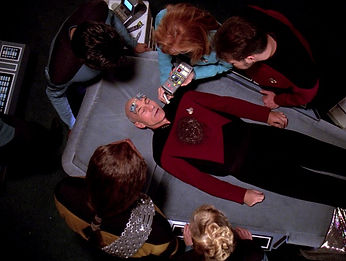
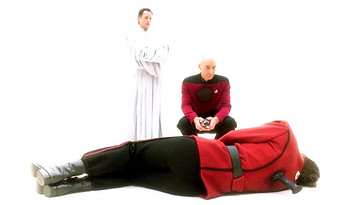

SERIES TOP 10
6.16/6.17 BIRTHRIGHT (I-II)
Worf discovers a Klingon prison camp in Romulan space.

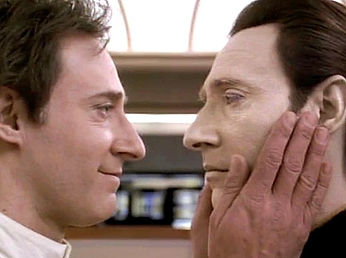
SKIPPABLE
After the S5-S6 cliffhanger “Time’s Arrow,” this is another two-parter that should have been a standalone. There is so much filler that half of the first part is wasted on a side story arc that adds nothing to the plot and is entirely absent from the second part. It would have been better to write one episode on Data’s dreams and another on Worf’s camp infiltration, and each would have been worthy in its own right. But as it stands, both are mediocre, and it’s quite telling that Data’s scenes are the best across both episodes. As for the prison camp, while the notion of Klingons and Romulans living together post-war has some potential, it never comes to full fruition thanks to uninspiring side characters and a grossly incoherent plot. The first part gives much attention to Worf’s upcoming quest to find his father, but that’s all forgotten at the drop of a hat when he reaches the camp --- and it’s not replaced by anything of even remotely comparable value, which results in a huge letdown. To make matters worse, his eventual willingness to die for a group of half-Klingon kids is baffling at best, and outright insulting in the episode’s final scenes. As a result, the whole two-parter is almost completely devoid of any emotional investment from the audience, and that’s a hard burden to shoulder for 90 minutes. It’s also a pity that this is the only true TNG-DS9 crossover episode, which is limited to a few scenes with Julian Bashir and a couple of shots of the Promenade.
Thieves try to rob the deserted Enterprise during a stopover.
6.18 STARSHIP MINE
This is a simple-minded adventure with a highly original setting and an interesting premise, and on these accounts it delivers just fine. There is no pretense of a “moral of the story,” nor any character development to speak of. Instead, there’s action and humor, sometimes good and sometimes redundant. The episode’s top strength is its setting aboard a deserted Enterprise, which we have not seen before in this context. Picard’s efforts to throw off a gang of thieves are well scripted and fun, even if they do employ too much violence for Star Trek. The hostage situation on the base, instead, is completely useless and clearly only devised to give the rest of the crew something to do. Fun fact: Tim Russ is the third VOY series regular to guest-star in TNG in another role, after Ethan Phillips and Robert Duncan McNeill.

SKIPPABLE
6.19 LESSONS
Picard falls in love with a musically inclined officer under his command.


SEASON BEST
Unpopular opinion: this is one of the finest episodes of all of Star Trek. It is the only time in TNG that the writers “get” romance right, and it is an exceptional chapter in Picard’s development. Knowing full well how successful “The Inner Light” was, the writers respect the audience a great deal by featuring it so prominently here, and with such tact and understated beauty. But it is Nella Daren to truly shine in this episode. Played with great nuance by Wendy Hughes, she is the perfect mate for Picard: strong, smart, sensitive, gorgeous, and a tiny bit younger than him. Their relationship is poetic and joyous. The script gives their music its due attention through a series of unforgettable duets, while sidestepping the petty drama that usually attends such stories (e.g., jealousies, misunderstandings, etc). It is a mature and sensible affair, centered on sharing art and each other’s wisdom. The episode’s final minutes are in a league of their own. It’s fully believable that Daren might die, so the audience is entirely invested in Picard’s emotional rollercoaster. When he sits alone at the end, we see just how isolated this man is, a recurring theme in TNG movies to come. And Picard’s and Daren’s eventual decision to separate is measured and heartfelt, in keeping with the rest of the script. For all that they have shared and learned, a fleeting moment of joy --- underscored by Jay Chattaway’s angelic musical themes --- is all that’s left. Fun fact: this episode barely missed my Series Top 10 rankings.
Picard continues his late mentor's archaeological quest to discover the origin of life.
6.20 THE CHASE
This is my least favorite episode of TNG, which is not to say that it’s the worst by any measurable standard. But it’s the one that misfires more than any others, grossly misunderstanding the scope and entity of its own implications. The story is one possible take on the panspermia hypothesis: a now-extinct ancient civilization inseminated thousands of planets throughout the galaxy, and the current inhabitants of the Alpha quadrant are able to reconstruct this fact through genetic archaeology. Not only that, but these ancient aliens encoded a message in the very fabric of our shared DNAs, so that their eventual descendants could one day realize the truth of their shared origin and come together in peace. That’s as close as science-fiction gets to finding God, or at least to answering the most basic metaphysical conundrums concerning the origins of sentient life. Surely this must deserve a sweeping epic, full of insightful conversations, acute investigations, and a momentous final revelation; or a minimalist piece where The Truth is revealed privately to one character, as in Carl Sagan’s Contact. Instead, we get nothing.
The episode starts off wonderful, with a series of stimulating dialogues between Picard and his former archaeology professor, Dr. Galen. That quickly transforms into a tale of regret and what-ifs as Picard is forced to reevaluate his life choices; and when Galen dies, it seems that this is now a story about Picard following in his mentor’s footsteps... which while a disappointing turn of events (poorly concealed daddy issues are still daddy issues, and daddy issues are awful narrative devices) it would have made for an interesting episode. But then the script drops the hammer: Galen’s discovery is the origin of all life in the galaxy! And yet nothing changes in the character’s dispositions. As far as they’re concerned, they’re still just following along on Picard’s professor’s little quest. Picard’s and Crusher’s occasional offhand comment about how big this is doesn’t suffice to relay to the audience just HOW BIG.
But the narrative coup de grace happens when Klingons, Cardassians, and Romulans join in the titular chase. Of all the ways to involve other civilizations, the writers chose an inept overweight Klingon captain, a flirtatious Cardassian commander, and a shady Romulan soldier. The exchanges between these characters and Picard are so badly written as to be unwatchable, chock-full of cliches and empty phrases. Not once, in the entire episode, does any character seem to truly grasp the magnitude of what is happening. Not once is there a reflection on how this discovery would affect science, religion, and the collective psyche of thousands of humanoid species. The ending makes all of this even worse, if possible. The appearance of the “ancient alien” is on point: Salome Jens, who would play the similarly ancient Founder in DS9 (the similarities are too obvious to bear repeating: the Founders may very well have been the ancient aliens), is an excellent pick, and the message itself that she delivers is interesting and exciting. But that too gets lost in the context of silliness and irrelevance that the script has established until that point.
I don’t hate this episode because it’s bad, though it’s oh so bad. I hate it because of what it should have been. Not just could: should. If you’re going to tackle science-fiction’s (and religion’s, and philosophy’s, etc.) oldest and most venerable question, you must do it justice. This script mocks it instead, and that is a capital offense.
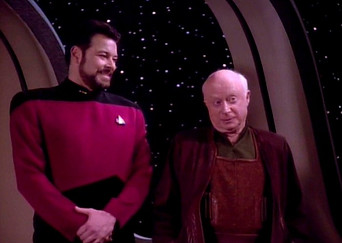

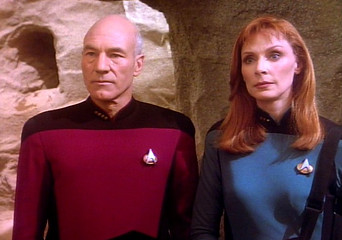

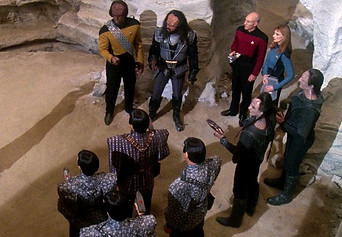
SKIPPABLE
6.21 FRAME OF MIND
Riker questions his sanity in an alien mental hospital.

...
’ “ ”

Crusher investigates the death of a scientist during a symposium.
6.22 SUSPICIONS
TNG writers have demonstrated good familiarity with the investigative thriller format (e.g., S3’s “A Matter of Perspective” and S4’s “Clues”). While this episode is not as good as those, it is a solid installment of the genre and an entertaining hour of television. Crusher is unlikely in the role of the diplomat-turned-investigator, which makes her all the more likable, thanks also to McFadden’s passionate performance. The mystery is well crafted, with an intriguing premise, an exotic setting in some seldom-seen areas on the Enterprise, and a creative (if not fully unanticipated) resolution. Crusher’s own involvement could have been designed better, as there’s no real reason for her to be reinstated other than “we need our series regular to continue.” But this is forgivable in an episode whose strengths lie in the ambiance of its presentation.

WORTH WATCHING
6.23 RIGHTFUL HEIR
Legendary Klingon God-Emperor Kahless returns after millennia.

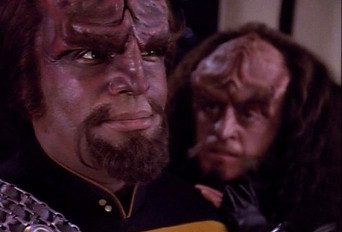
SKIPPABLE
With all the political turmoil we have witnessed over several seasons, it was high time that Klingon spirituality got some attention. But it’s quite upsetting that this is the episode that we get to address these issues, for just like “The Chase” it also bites off a lot more than it’s willing to chew. It reduces a spiritual quest of massive consequence to a series of commonplace exchanges in caves and conference rooms. It has nothing of the grandeur that would be expected of such an epic tale: no pomp, no circumstance, no soul. Just like the clone of Kahless himself, the script is a bad copy of what an episode of this magnitude could or should have been. If it had been done right, it could have been a worthy sequel to the Klingon civil war arc but focusing on spiritual matters. Kahless’ eventual installation as Emperor and spiritual leader would come after palace intrigue, epic battles, and an exploration of Klingon religious life on Qo’nos. Instead we get a monastery and a starship. The script’s only redeeming quality is the conversations between Worf and Data on faith vs. reason, though these too are simplistic and miss out on a much more intriguing conversation. The episode isn’t bad per se, but a good opportunity is a terrible thing to waste, so the rating is affected as well.
A transporter accident brings back a past version of Riker.
6.24 SECOND CHANCES
There were more modest ways to explore Riker’s what-ifs vis-a-vis Troi and his career, but this script jumps the shark through an outlandish scenario --- and that gamble pays off in full, as the resulting episode is entertaining and rarely overstated. As always, it’s a little baffling how the characters react with poise to as major a mindfuck as this one, but such is the nature of sci-fi shows. If we, the audience, suspend disbelief enough to buy into the transporter accident premise, we’re rewarded with a genuinely thorny dilemma, moral and psychological. The script focuses primarily on the latter by following the Will-Deanna story arc, which turns out to be a wise choice. “Thomas” Riker’s interactions with Troi are sweet and believable, as is their eventual decision to split up again as, once more, he picks his career over his love life. The resulting triangle, so to speak, is certainly awkward, but in just the right way that one would expect from such a situation. If anything, it’s the Riker vs. Riker rapport that feels strained and out-of-character. Much of the tension and rivalry between the two seems written in ad hoc to create drama, which isn’t quite necessary. Still, the episode works well and is entertaining from start to finish. And while it’s a pity that the script doesn’t pay better attention to the philosophical side of its underlying dilemma, as an artistic choice that’s understandable. (Fun fact: Mae Jemison, NASA astronaut, appears as transporter chief Lt. Palmer!).

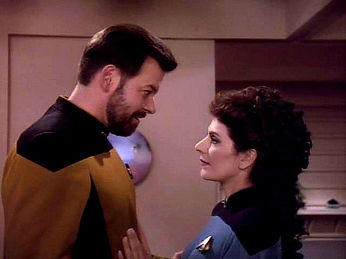
WORTH WATCHING
6.25 TIMESCAPE
Picard, Troi, Data, and La Forge find the Enterprise frozen in time.
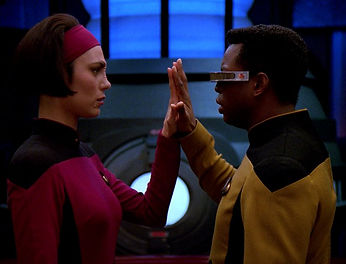

WORTH WATCHING
...
’ “ ”
